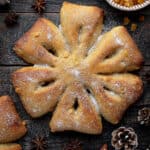
Orange and Anise Snowflake Bread (Vegan Gibassier)
Soft, sweet, light and buttery orange and anise flavoured breads (Gibassier), shaped like snowflakes. Perfect for Christmas and the festive season.
Servings 2 loaves
Ingredients
Starter
- 100 ml (⅓ cup + 1tbsp + 1tsp) unsweetened non-dairy milk (I use soy)
- 80 g (⅔ cup) white bread flour
- 7 g (2 tsp) fast action yeast
Dough
- 100 ml (⅓ cup + 1tbsp + 1tsp) unsweetened non-dairy milk (I use soy)
- 42 g (50 ml/scant ¼ cup) olive oil
- finely grated zest of 1 large orange
- 2 teaspoons orange blossom water
- 280 g (2 + ⅓ cups) strong white bread flour
- 85 g (⅓ cup + 1tbsp) caster (superfine) sugar
- 1 teaspoon salt
- 60 g (¼ cup) softened vegan butter
- 1 teaspoon ground star anise
- 75 g (2.65 oz) candied peel
- milk to glaze
- melted butter and caster sugar to finish
Instructions
- To make the starter, heat the milk until it is lukewarm (not hot). Mix together the flour and yeast in a large bowl (the bowl of your stand mixer if you have one), beat in the milk until smooth then cover and leave in a warm place for about 30 mins until risen and bubbly.
- To make the dough, beat the milk, olive oil, orange zest and orange blossom water into the starter. It doesn't matter if it isn't smooth.
- Add the flour, sugar and salt and mix on low for about 6 minutes, scraping down the sides of the bowl occasionally. Increase the speed to high and mix for 2 more minutes until the dough is smooth and elastic. It should pass the windowpane test.
- Add the butter and mix on a medium speed until fully combined and smooth. It will look greasy and messy at first but it will come together eventually! Scrape down the sides of the bowl a few times as needed. The dough should be smooth and elastic and slightly sticky but not wet. If it is too wet you can add a bit more flour, a spoonful at a time.
- Finally add the star anise and candied peel and knead through until well distributed.
- Place the dough in a lightly oiled bowl, cover and leave to rise in a warm place until about doubled in size, about 1 ½ to 2 hours.
- Knock back the risen dough and turn out onto a lightly floured surface. Divide into two equal pieces and shape each one into a ball. Line two baking sheets with baking parchment.
- Flatten each ball of dough with your hands into a disc about 1.5cm thick and place each one on one of the baking sheets. Cut the disc into six sections, leaving them connected at the center.
- Cut a slit in the center of each section. It is best to use a straight, rigid piece of metal or plastic to press straight down through the dough, guillotine-style, rather than dragging a knife through the dough.
- Pull the sections outward to separate and elongate them a little. Use your fingers to open out the slits and form a V-shape in the top of each section.
- Cover each loaf loosely with oiled clingfilm and set aside to rise in a warm place for about 45 minutes to 1 hour until puffy. If you press the dough lightly with a fingertip it should feel light and spring back slowly, leaving a slight indentation. If it springs back quickly it needs to rise for a little longer.
- Meanwhile preheat the oven to 180°C/160°C fan/350°F/gas mark 4.
- Gently brush each loaf with a little milk then bake for 20-25 minutes until golden and cooked through (the internal temperature should register 94°C/200°F on a probe thermometer). Rotate the trays halfway through baking.
- Slide the loaves onto a wire rack and brush with melted butter and sprinkle with caster sugar (or dust with icing sugar) while still warm.
Notes
- As with all of my baking recipes I really do recommend using the metric measurements with a digital scale rather than the cup conversions. Cups are a wildly inaccurate measuring system and you will get far better, more consistent results using a scale, not to mention that it is also easier and less messy than cups!
- See post above for tips, details and step-by-step photos.
- You can mix the dough by hand if you don't have a stand mixer but it is very sticky and messy and will need to be kneaded for at least 10 minutes until very smooth and elastic before mixing in the butter then the anise and peel.